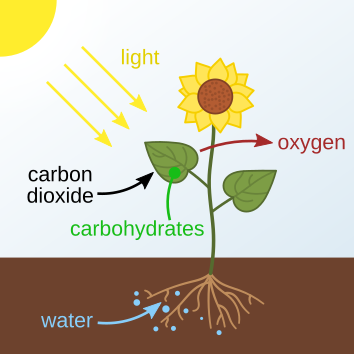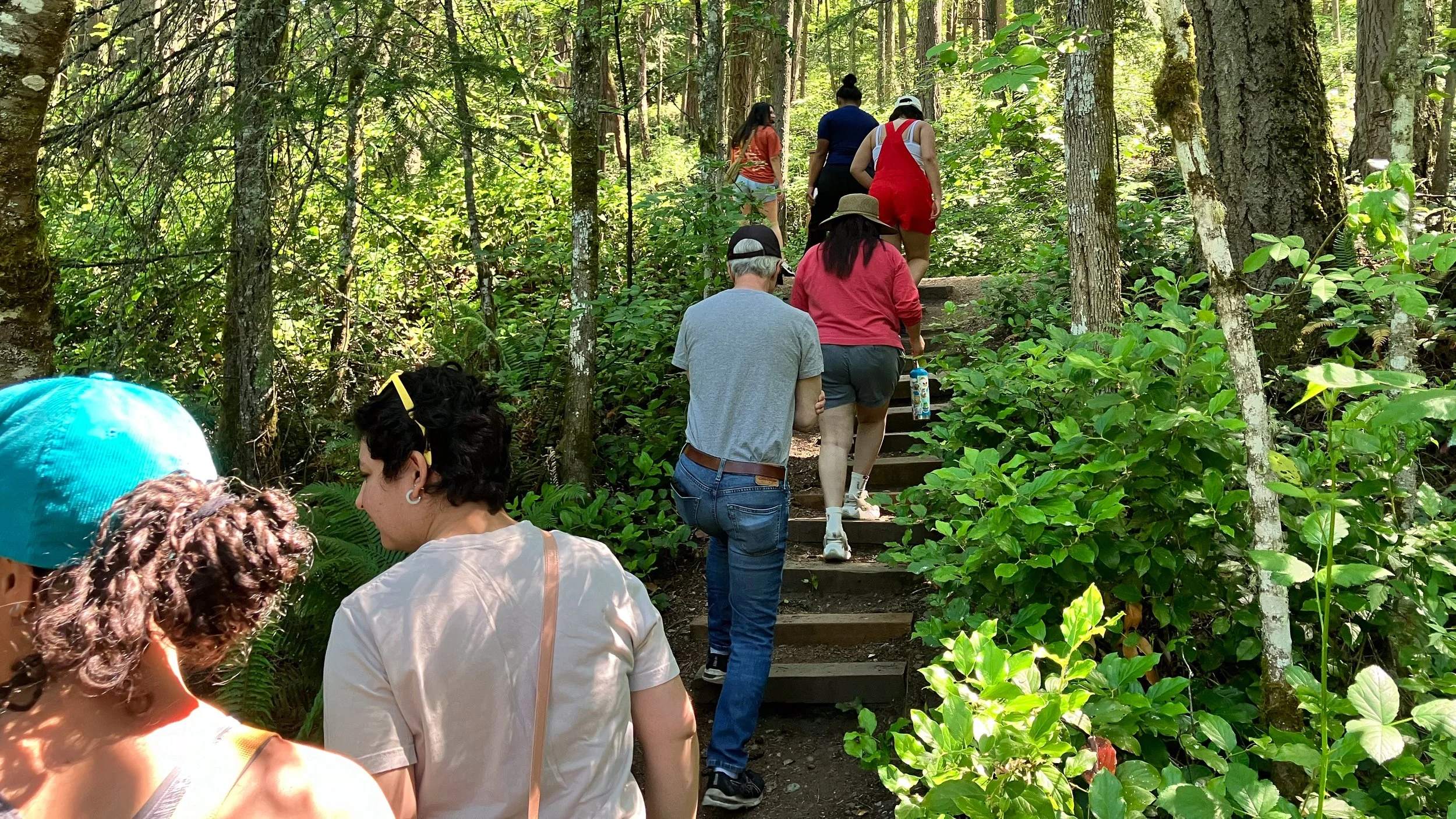Tree Benefits, Part 2: A Healthy Home
Trees are incredible beings that provide countless benefits to our communities. In forests, rural, and urban environments, trees are impacting our daily lives. They sustain our mental and physical health, and the ecosystems around us, playing a crucial a role in creating a safe and livable home for us all.
“For so long, we’ve thought of green space as an amenity or a perk, we’re trying to reframe it as an essential part of thriving as human beings”
Air Quality
Trees improve our air quality both directly by reducing CO2 and fine particulate matter, as well as indirectly by lowering the energy consumption of buildings around them.
Source: Wikimedia Commons
Breathing in CO2
Trees breathe just like us. While we breathe in oxygen and breathe out carbon dioxide (CO2), trees breathe in CO2 and breathe out oxygen. Whereas we use our lungs, trees breathe and eat using the chloroplast inside their cells through a process called photosynthesis, from which they derive nutrients and energy. The inputs for photosynthesis are CO2, sun, and water; and the outputs are oxygen and glucose!
So, how exactly does this affect the air quality? CO2 is a greenhouse gas (GHG) that causes the earth’s atmosphere to trap heat at a faster rate. Although CO2 is naturally occurring and necessary in our atmosphere, there is an increased quantity due to the exhaust from our vehicles, buildings, and industries. When trees are planted in urban settings, they absorb excess CO2 emitted from streets and highways, factories and electrical appliances, a process called carbon sequestration.
Reduced energy consumption
In 2019, Tacoma emitted approximately 1.7 million metric tons of GHGs. 19% of these emissions were from commercial and residential sources, emitted mostly by the use of natural gas and electricity to heat and cool buildings or water. In Part 1 of this series, “Silent Superheroes”, we highlighted how trees insulate buildings and streets, reducing the amount of energy needed to keep them warm in the winter and cool in the summer. This reduction in energy, lowers the amount of fossil fuels emitted into the air.
Catching particulate matter
Trees can also act as a feather duster but instead of catching the dust inside your home, they temporarily collect the fine matter in the air. These small pieces of particulate matter come from a variety of sources around the city, both natural and anthropogenic (human- made), some are large enough to see and others microscopic. Fine solid and liquid particulates can cause haze and be inhaled, potentially causing adverse health effects. Air quality is measured daily and quantified into the Air Quality Index (AQI) which is reported by a number of weather sources. You can check the AQI and receive alerts when the air quality reaches harmful levels in your area. Tacoma Tree Foundation is currently partnering with The Nature Conservancy to track air quality in our city as part of our G.R.I.T project. Stay tuned for updates on this project in the fall.
Habitat
A habitat is a place that meets an organism's needs to eat, sleep, and successfully reproduce. Sometimes, a single tree can fulfill all of these needs, creating the perfect habitat for wildlife. In fact, even after death, trees continue to support animals and plants. In all these ways, they support ecosystems by creating important symbiotic relationships with wildlife and other plants that promote biodiversity.
Shelter
Birds, squirrels, and raccoons all nest in trees, foraging to create homes out of twigs and other organic materials as well as by seeking shelter in hollowed out cavities. Trees are also a habitat for insects, fungi, mosses, and frogs. They even provide a place for plants such as the licorice fern whose roots creep up the trunk and produce beautiful fronds.
Food
All tree parts are edible. Bark and wood are eaten by beavers, insects like termites, as well as deer and rabbits in the spring. The fruit and seeds of trees feed countless foragers including birds, bears, and bats. Birds such as sapsuckers, insects, and porcupines, love snacking on tree sap. Finally, flower nectar attracts a plethora of pollinators such as butterflies, bees, moths, and hummingbirds that play a crucial role in plants’ reproductive cycle.
Even after a tree dies, it can be overflowing with life! Insects that take up residence and lay eggs provide food for birds; decomposers such as fungi, bacteria, earthworms and insects work to break down and recycle the stored nutrients; and the decaying tree can even become a nurse log to help raise the next generation of trees.
All of the roles trees play in our ecosystem are but a few reasons why biodiversity in our environment is so important. Diversity of trees means diverse habitats for the plants, animals, and insects that rely on them for food, shelter, and space to live.
Mood and Mental Health
“Tree Benefits Part 1: Silent Superheros” explored how trees reduce road rage and lead to safer driving. This effect doesn’t just happen when driving. There is a strong correlation between the presence of trees and good mental health and tranquility. In 1982, Tomohide Akiyama, the Japanese Minister of Agriculture, Forestry and Fisheries coined a term shinrin-yoku (forest bathing) for the innumerable benefits trees bring to us. The calming green, the soft sound of leaves rustling, even the smell of trees, contributes to positive attitudes and decreased stress. In fact, for every 1% increase in green space, those who live in urban areas have a corresponding decline in stress levels.
Living in an area with green spaces and access to trees has been shown to significantly increase mental health. Mental health studies have found that trees are the common denominator among those who spend regular time in green spaces and an improvement in their mental health. One study found that just living within 100 meters (330 feet) of street trees can reduce the necessity of prescribed antidepressants. Another found that in neighborhoods with 30% or greater tree canopy coverage, adults were 31% less likely to develop psychological distress. The City of Tacoma has a goal of increasing the average tree canopy from approximately 20% to 30% by 2030.
You can find the canopy coverage for your home by visiting American Forest’s tree equity score map. Notice which neighborhoods have the highest tree canopy and which are the lowest.
Beyond boosting mood and improving mental health, regular exposure to trees has been shown to improve memory attention span, and other cognitive functions. It is especially critical for children to be exposed to nature, trees, and green spaces. One study researching the influence of green space on cognition in children 4 to 6 years old, found that those living closer to green spaces had less hyperactive behavior and achieved better scores on attention and visual memory tests. The positive effects of trees last through school and into adulthood. Students who can see trees from their classroom windows have fewer behavioral incidences. Finally, children who live near residential green spaces for the first ten years of their lives have a lower risk of developing psychiatric disorders during adolescence or adulthood.
Peter James, Adjunct Associate Professor of Environmental Health at Harvard T.H. Chan School of Public Health who has done extensive research on tree benefits stated that “For so long, we've thought of green space as an amenity or a perk, we're trying to reframe it as a fundamental driver of health outcomes, and an essential part of thriving as human beings”.
Trees’ role in supporting habitats, air quality, and mental health are some of the many reasons why we, at the Tacoma Tree Foundation, hold equitable access to trees as a core value. Our work is focused on serving neighborhoods with the lowest tree canopy, and our goal is to provide trees to communities with less access to trees and green spaces.
Take a deep breath outside with a friendly tree, listen to the birds that dwell in them, and show gratitude for all that they do in our communities. If you would like to help bring more trees to underserved communities, sign up to be a volunteer and plant a tree for your neighbors.
Chances are it will do good for years to come!
Stay tuned for a future blog post on how trees help us lead healthier lives.




